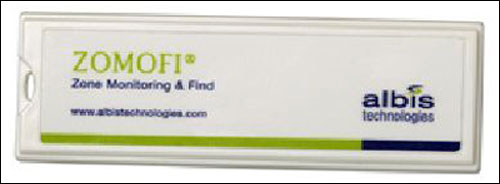Protecting art and artifacts at museums can be a complex task that requires security guards, as well as technology, to watch over valuable items in public places. Usually, the technology consists of permanent wired motion detectors around the building’s exhibits. Some museums in Europe, however, are employing a solution featuring active RFID tags coupled with sensors from Swiss telecommunications products firm Albis Technologies that enables them to wirelessly protect their high-value exhibits from damage or theft. Albis’ ZOMOFI (Zone Monitoring & Find) system detects motion, triggers an audible alarm if a work of art or other valuable item is moved, and alerts staff members electronically so that they can respond.
Albis provides asset-management solutions for use in logistics, people safety, petrochemical and mining applications, railways and museums, as well as various customized solutions. The museum system is currently in use at sites in Sweden, Germany, Switzerland and France; all museums using the system have asked to remain unnamed.
Museums typically need to monitor not only the security of valuable pieces of art, but also environmental conditions, such as the presence of high temperatures or water, that could cause damage. Although wired solutions exist to recognize such hazards, some museums prefer a solution that does not require the running of cables, either for aesthetic reasons or because the exhibits often change or move, meaning that a system might need to be relocated in order to accommodate a new exhibit. Thus, the Albis system is designed to be more nimble, says Zeno Stämmer, Albis Technologies’ VP of active RFID.
The system consists of battery-powered RFID tags that transmit at 2.4 GHz, using a proprietary air-interface protocol, to Albis readers (known as controllers) installed within the room, as well as the company’s ZOMOFI edgeware, to manage read data and route that information to a museum’s back-end security or exhibit-management systems. Several different versions of the Albis tags come with either a built-in motion sensor or temperature and moisture sensors. If the system detects that a tag, attached to an item, is in motion, an audible alert similar to a siren is sounded, thereby warning the individual holding that object that its movement is unauthorized. If the item continues to move, the ZOMOFI edgeware can trigger the next level of alert, which could include messages sent to the staff, or alarms sounded throughout the building.
The tag is attached directly to an item via adhesive or wire. Museums employ specialists who prepare artwork for hanging; these individuals typically attach the tags in such a way that they will not damage the art. Once installed, the tags transmit at a pre-set interval to the controllers, which forward each tag’s unique ID number and sensor update, via a Wi-Fi or cabled Ethernet connection, to the ZOMOFI edgeware, which then interprets the read data and interfaces with the museum’s existing management software. The tags also transmit their own battery-life data, issuing an alert if the batteries are running low on energy. Typically, Stämmer says, the batteries last for five to 12 years.
Albis’ first museum installation took place in a Swedish museum in 2008. Since then, Stämmer says, the company’s technology has been adopted by approximately seven museums, with the most recent installation occurring in November 2010. One of those museums is currently preparing to expand its use of the system.
Two or three controllers provide sufficient coverage for all of the tags within a typical room—generally measuring 50 meters by 100 meters (164 feet by 328 feet) in size. The sensor tags can travel with a piece of art from an exhibit to storage, and then to another location, and if controllers are in place, the system will continue to detect the artwork’s presence and ensure that it is not being moved at unauthorized times. A tag can beacon its unique identifier at a variety of rates, Stämmer says. “We have good results at eight to 20 seconds,” he explains, which is frequent enough to detect the movement of a piece of art, but infrequent enough to ensure the battery’s long life.
In situations whereby a controller ceases to receive transmission from one of the tags, an alert can be sent to the museum management, indicating that a transponder has vanished from the system. This function would enable the facility to detect an instance in which a tag was disabled by a potential thief.
For the past several years, Integrated Security Information Systems (ISIS) has offered a similar solution for tracking artwork (see RFID Protects Tut’s Treasures and RFID and the Arts), as have a number of other companies (see Art Dealer Finds Beauty in RFID Tracking System and The Art of Tracking Masterpieces).


